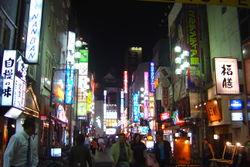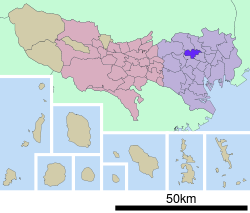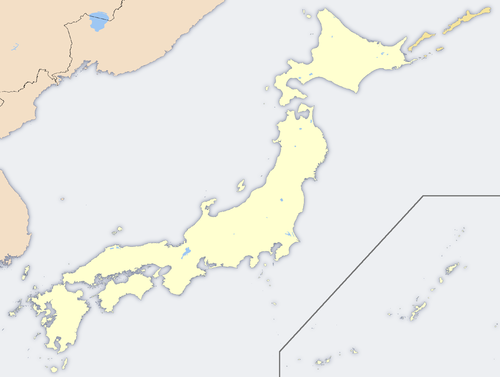Toshima, Tokyo
| Toshima 豊島 |
|||
|---|---|---|---|
| — Special ward — | |||
| 豊島区 · Toshima City | |||
 |
|||
|
|||
 |
|||
 Toshima
|
|||
| Coordinates: | |||
| Country | Japan | ||
| Region | Kantō | ||
| Prefecture | Tokyo | ||
| Government | |||
| - Mayor | Yukio Takano | ||
| Area | |||
| - Total | 13.01 km2 (5 sq mi) | ||
| Population (2005) | |||
| - Total | 252,011 | ||
| - Density | 19,370/km2 (50,168.1/sq mi) | ||
| Time zone | Japan Standard Time (UTC+9) | ||
| Website | Toshima | ||
Toshima (豊島区 Toshima-ku) is one of the 23 special wards of Tokyo, Japan. Located in the north-west corner of the ward area, Toshima is bordered by the cities of Nerima, Itabashi, and Kita in the north, and Shinjuku and Bunkyo in the south.
The ward was founded on March 15, 1947 and reached a peak resident population of 370,000 in 1965. The population has continued to decline and as of December 1, 2005, the ward had an estimated population of 252,011 with a density of 19,370 persons per km². During the day the population swells with commuters, resulting in a daytime population of around 430,000.
The total land area of Toshima is 13.01 km², sitting on a moderate plateau with a difference of 28 m between the ward's highest and lowest points. Approximately 47% of Toshima's land is residential, and 20% is commercial and public areas.
Though Toshima is a ward, it refers to itself as a city. The ward offices are located in Ikebukuro, which is also the commercial and entertainment center of Toshima.
With a non-Japanese population of 15,516, or 6.16% of the total, Toshima is one of the most international wards in Tokyo. Of the foreign population, 56% is of Chinese descent, 20% is of Korean descent, followed by Filipinos.
Contents |
History
Toshima was formed in 1932 by the merger of four towns, Sugamochō, Nishi-sugamochō, Takadachō, and Nagasakichō, bordered by the quickly expanding former city of Tokyo.
The area evolved from a suburban agricultural district in the Edo period to the urban commercial center that it is today. The growth was fueled by the construction of various rail lines built in the Meiji and Taishō period.
The former Somei village, now part of Toshima, is the birthplace of the Somei Yoshino, Japan's most popular variety of sakura (cherry blossom tree). The variety was developed at the end of the Edo period.
Politics and government

Toshima is run by a city assembly of 36 elected members. The current mayor is Yukio Takano, an independent backed by all major parties except the Japanese Communist Party.
Neighborhoods
|
|
Sights

- Sunshine City: The focal point of much of the entertainment in and around Ikebukuro, Sunshine City sports some of the best shopping and dining in Toshima.
- The Ancient Orient Museum
- Morikazu Kumagai Art Museum
- Tokyo Metropolitan Art Space: Near Ikebukuro Station, this facility built in 1990 is one of the newer spots in Toshima and has a concert hall with regular performances and art exhibitions. There is a stage in the open space out front and it is a popular place for amateur musicians during the warmer months.
- Myonichikan of Jiyu Gakuen Girls’ School: Designed by famous American architect Frank Lloyd Wright, this notable building was completed in 1922, shortly before he completed work on the Imperial Hotel.
- Sugamo Jizodori: The shopping district known as "old ladies' Harajuku."
Festivals
- Fukuro Matsuri: This festival started in 1968 and features a parade of mikoshi (portable shrines) and a yassa dance. It is held on September 14 and 15 of each year outside the west exit of Ikebukuro Station and attracts as many as 200,000 people.
- Otsuka Awa Odori Dance: A large summer event gathering 150,000 people, this festival features groups performing and competing with colorful costumes and dancing in front of JR Ōtsuka Station.
- Nagasaki Shishimai (lion dance): The lion dance is performed every year on the second Sunday of May at Nagasaki Shrine.
Economy
Seiyu Group has its head office in Toshima.[1] Libro, a bookstore chain, is headquartered in Toshima.[2]
In 1956 Asatsu Inc. established its headquarters in Meijiro, Toshima. In May 1967 the company's headquarters moved to Shinbashi, Minato.[3]
Education
There are four Universities in Toshima:
- Gakushuin University
- Tokyo College of Music
- Rikkyo University or St. Paul's University
- Taisho University
Tokyo Metropolitan Government Board of Education operates area public high schools.
Transportation
Rail
The main hub for rail transportation in Toshima ward is Ikebukuro Station, the second busiest train station in Japan.
The rail lines which run through or terminate in Toshima are:
- East Japan Railway Company (JR East)
- Saikyō Line
- Shōnan-Shinjuku Line
- Yamanote Line
- Seibu Railway
- Seibu Ikebukuro Line
- Tobu Railway
- Tōjō Line
- Tokyo Metropolitan Bureau of Transportation (Toei)
- Mita Line
- Toden Arakawa Line
- Also known as the Arakawa Metropolitan Streetcar Line, it is Tokyo's only remaining streetcar line.
- Tokyo Metro
- Tokyo Metro Yūrakuchō Line
- Tokyo Metro Marunouchi Line
- Tokyo Metro Namboku Line
Famous people
See also
References
- ↑ "Corporate Data." Seiyu Group. Retrieved on May 19, 2009.
- ↑ "会社案内." Libro. Retrieved on May 19, 2009.
- ↑ "Corporate Overview." Asatsu-DK. Retrieved on November 9, 2009.
External links
- Toshima official website Scroll down and click on "English" to translate.
- Wikitravel: Tokyo/Toshima
|
|||||||||||||||||
|
|||||||||||||||||||
